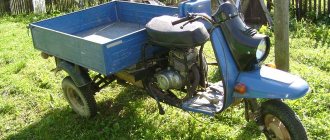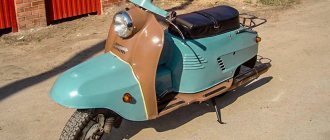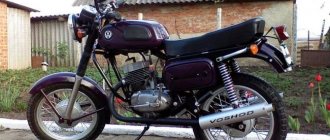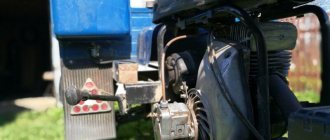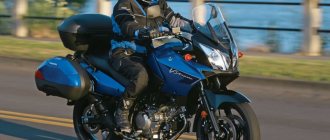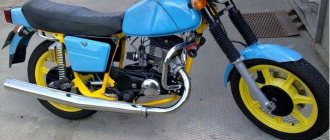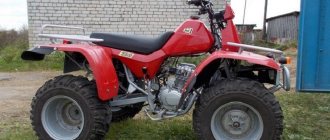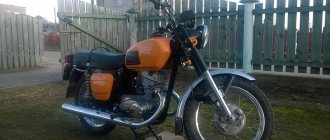In January 1978, from the assembly line of the Tula plant named after. Ryabikov got a new scooter “Tulitsa” (photo below).
True, it can be called new only nominally; in fact, it was a modernized model of the Tourist-M. Even externally, it is quite difficult to distinguish them: additional side engine cooling louvers and the kick-starter pedal, which was now located outside, are, perhaps, the whole difference. As for the “internal” transformations, they were really significant in the car.
Total information
Scooter base, mm – 1400 Ground clearance at full load and normal tire pressure, mm – no less than 125 Overall dimensions of the scooter, mm Length = 2080 Width along the handlebar with mirror, no more than 950 Height – 1200 Weight (dry), kg – no more than 140 Maximum load (including driver), kg – 170 Maximum speed, km/h – no less than 97 Braking distance with full load when driving at a speed of 30 km/h, m – no more than 7.0 Fuel consumption per 100 km at driving at a speed of 45 - 50 km/h on the highway, l - no more than 3.2 at a speed of 73 km/h - no more than 4.5.
Return to content — ↑
New clutch
Along with the updated engine, the Tulitsa scooter also acquired an improved clutch: the old four-disc version was replaced with a six-disc one. Thanks to an additional pair of disks, as well as a damper built into the design, which connected the driven chain sprocket to the drive drum, its overall reliability and durability increased significantly.
It is worth noting that the improved clutch, provided it was equipped with a new cover, could also be installed on older models of scooters from the T-200 series.
Engine
Number of cylinders – 1 Cylinder diameter, mm – 62 Piston stroke, mm – 68 Compression ratio – 66 Cylinder displacement, cm³ – 199 Maximum engine power At 5200 – 5800 crankshaft rpm, l. With. – not less than 14 Maximum torque at 4900 – 5500 rpm, kgf•m – 1.6 Lubrication system – together with fuel Ignition system – battery Carburetor type – KA-36F or K-62G Fuel used – mixture of A76 gasoline and oil M-8V or M-63/10G1 or MS-20 oils Air filter - inertial oil Cooling - forced by fan Starting system: with direct current - dynastarter or kickstarter
Return to content — ↑
Description
The production of the scooter began back in 1979, at the plant named after V.M. Ryabikova. This model “came” to replace the “Tourist-M”. The appearance is in many ways reminiscent of an “older comrade”. But there are still differences. We list them: the external location of the kick starter, the holes provided on the body for ventilation of the internal space. To get a closer look at the equipment, it is recommended to view a photo of the Tulitsa motor scooter.
In terms of technical characteristics, the scooter has improved. Thus, the productive element produces 2 units of power more than the Tourist-M2. The increased power was the result of improved cylinder scavenging and compression ratios. For better thermal conditions, a new cylinder was installed on the new model, and the location of the spark plug was changed to central. The cylinder is fastened using 4 long studs.
Greater power left fuel consumption unchanged. That is, this did not affect the efficiency in any way. There are three rings on the piston (there are 2 rings on the Tourist-M). The roller bearing in the connecting rod was replaced by a needle bearing.
There were some changes to the frame on this model. “Tulitsa” is equipped with a much stronger power frame. This was achieved due to the installation of a new side cross member and reinforced gussets. The engine mount located at the rear has been modernized.
Power transmission (transmission)
Clutch - damper, multi-plate in an oil bath Gearbox - 4-speed Gear shift - foot Gear ratio from engine to gearbox - 2.353 Transmission from engine to clutch - chain type PV-9, 525–1200 GOST 13568=75 50 links Transmission from gearbox to the rear wheel - chain type PR-12.7 1820-2 GOST links Gear ratio - 2.235 General gear ratios of the gearbox: In first gear - 3.000 In second - 1.644 In third - 1.235 In fourth - 0.900 General gear ratios from the engine to the rear wheel: In first gear - 15.777 In second - 8.646 In third - 6.495 In fourth -4.733
Return to content — ↑
Where can I buy Tulitsa?
After 1995, TULAMASH completely stopped producing previously developed motor vehicles, switching to a different type of product. However, lovers of two-wheeled rarities still have the opportunity to purchase a Tulitsa motor scooter. Avito, an online site where individuals post advertisements for the sale of various goods, today offers a fairly large selection of these cars. The price of the model depends on its appearance and general technical condition. If necessary, you can also purchase spare parts for this vehicle there.
In a word, if you want to have a “Tulitsa” in your garage, then it all depends on desire and financial capabilities.
Chassis
Frame - tubular welded Front wheel suspension - long-link with spring-hydraulic shock absorbers Rear wheel suspension - lever with spring-hydraulic shock absorbers, unified with the shock absorbers of the front suspension (except springs) Wheels - detachable, tires with rims are interchangeable Brakes - shoe shoes with a diameter of 150 mm Tire size , inches – 4.00-10 Tire pressure, kgf/cm²: Without a passenger Front wheel – 1 Rear wheel – 1.5 With a passenger Front wheel – 1.2 Rear wheel – 2.5
Return to content — ↑
Other changes in the Tulitsa design
One of the disadvantages of previously produced Tula cars was the not very strong frame. When designing the Tulitsa motor scooter, the designers tried to correct this issue by strengthening it with another tubular cross member and two gussets.
In addition, the side stand also changed its place, “migrating” from the right side to the left.
The transformation also affected the muffler; now it was fixed in two places through special rubber gaskets, which significantly reduced the noise level and increased its service life.
There were also some changes in the wheels: their hubs were combined with brake drums made of aluminum alloy, the use of which reduced the weight of the wheel and accelerated heat transfer. Thanks to this, the braking process has become more effective.
The rim remained detachable as before, only now it was attached to the drum with six bolts, and not four, as before.
To ensure a more reliable supply of fuel, the Tulitsa tank was equipped with a simple pressurization system, thanks to which excess pressure was created in the fuel tank, and gasoline was already supplied under pressure to the carburetor.
Electrical equipment
Electricity source - 6MTS9 12V battery Ignition coil - B51 Dynastarter - DS-1A, power 87.5 W Regulator relay - PP121 Ignition switch - VK330-B Turn signal switch - P201 Light switch with horn button - P25-A Switch - VK26 -A2 Signal - S205B Headlight (optical element) - FG50-G with lamps A12-50+40 and A12-1.5 or A12-1 Capacitor - K42-18-9 Rear light with brake light, lamps - A12-1 , A12-21 Direction indicators, lamps – A12-21 Brake light switch – VK854 Speedometer SP-131 Spark plug – A17B Portable lamp – A12-1 Light breaker RS57-B
Return to content — ↑
Data for adjustments
The owner of Tulitsa should remember or write down the following data:
- the gap between the breaker contacts should be in the range from 0.4 to 0.7 mm;
- the gap between the electrodes of the spark plugs should be maintained in the range from 0.5 to 0.6 mm;
- free play of the clutch lever varies from 5 to 20 mm;
- the free travel parameters of the lever, but of the hand brake, will be from 5 to 15 mm;
- for free travel of the foot brake lever, the data is 5-15 mm;
- when setting the ignition, the advance indicators to top dead center will be 3.2-2.8 mm;
- on the rear wheel, the sag of the drive chain should be 15-25 mm.
Based on these parameters and data, each Tulitsa owner will be able to set the basic settings with his own hands and ensure the efficient operation of the entire scooter.
Dynastarter
However, it is not only the engine that can make a motorcyclist clearly see all the components of his motorcycle. The most common problem is a problem with the dynastarter. The engineers of the Tula plant installed it in Muravya, instead of a conventional alternating current generator.
Why is it so important? If you notice a red light on the instrument panel while the moped is running, it means you are running out of charge. This happens because the generator is not producing alternating current. To begin with, in such a situation, it is necessary to check the integrity of the wires connected to the dynastarter and the relay regulator. If everything is in order, then the problem lies directly in the dynastarter. There may be three main causes of problems:
- difficulty in rotor operation (dirt getting into the collector or dust accumulation);
- freezing or wear of brushes;
- violation of the integrity of electrical equipment.
Since in most cases the operation of the dynastarter is difficult due to contamination of the collector, it is worth carrying out a simple disassembly according to the instructions described in the moped operating book. The main rules when working are neatness and cleanliness. After disassembly, be sure to thoroughly rinse all parts in gasoline and lubricate the rubbing parts, and under no circumstances throw away the parts.
Maintenance and repair
Thanks to its light weight, this moped, if necessary, can be laid on its side -187, even alone. Also, given that Ant disc wheels consist of 2 halves bolted together, replacing a damaged tire is quite simple. To connect the tube and the spare tire, it is necessary to separate the parts of the removed wheel.
Motor scooter repair Ant
Tools
In order to properly repair a Soviet moped, you will need the following tools:
- double-sided wrenches (set), 4-22 millimeters,
- screwdrivers - 3 pcs. (large, medium, small),
- hammers, 2 pcs. (100 and 300 grams),
- combination forceps,
- wooden stick,
- wire cutters,
- pliers,
- socket wrenches (4 pcs.),
- velvet files - 2 pcs. (flat).
Diagnostics
The Ant scooter must undergo regular maintenance. This is necessary for two reasons:
- This will improve performance characteristics and thereby make the model more reliable and durable.
- Timely diagnostics will allow the owner of such a rare motor vehicle as the Ant scooter to avoid an accident.
Unfortunately, not every owner of such a Soviet rarity as the Ant motor scooter regularly visits the service. Often, 171 units of equipment and 187 units of destroyed equipment are received for repair.
Scooter maintenance
Professional servicing of Ant is a series of operations through which the scooter remains in impeccable condition. Scooter Ant needs:
- daily cleaning,
- washing,
- lubrication,
- oil change,
- adjusting brakes and breaker,
- changing used tires.
If maintenance is not regular, the Ant scooter will require major repairs, which implies a serious financial and time investment.
If a scooter requires urgent replacement of a damaged or worn part, then repair work cannot be avoided.
It is important to remember that only a highly qualified specialist should repair a scooter, who always has the necessary tools at hand. A Soviet scooter in most cases undergoes one of three types of repairs:
A Soviet scooter in most cases undergoes one of three types of repairs:
If a scooter needs routine repairs, it does not require much time or removal of a large number of parts. If the Ant scooter requires average repairs, then the owner must take care of disassembling the engine or some elements of the chassis. If the Ant scooter needs a major overhaul, this means that it is time to completely disassemble the chassis or engine and replace all worn parts. To avoid risks, without sufficient qualifications, major repairs should be entrusted to an experienced specialist.
Motorcycle legends of the USSR - TMZ 5.402 “Ant 2M”
https://youtube.com/watch?v=Itoh81E7HCk
We bring to your attention a review of the legendary Ant tricycle. This Soviet cargo moped with three wheels has earned wide popularity among the residents of our country almost from the moment of its release. First of all, the vehicle was highly appreciated due to its affordable price and versatility. In addition, the performance of the bike stood out. With a weight of 240 kg, the vehicle could transport loads weighing 250 kg, as a result of which it became an indispensable assistant in agriculture.
And today the Ant scooter is highly valued among our compatriots. Its functional parameters have not lost their relevance today. As a result, in rural or summer cottages you can quite often find such a tricycle.
